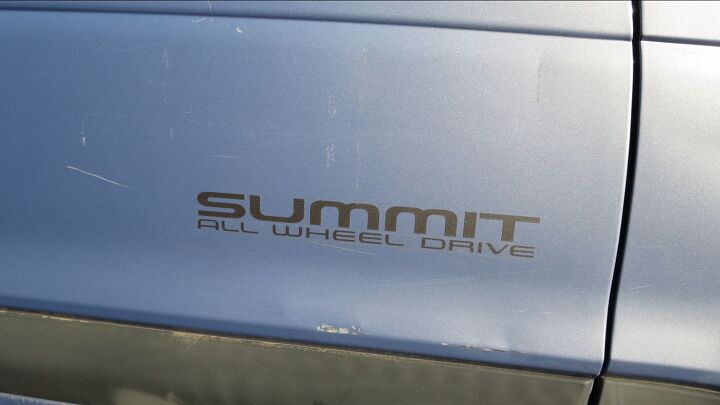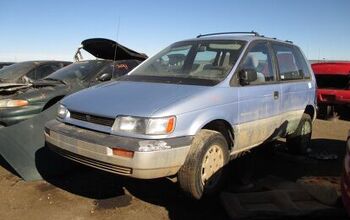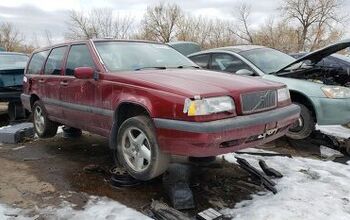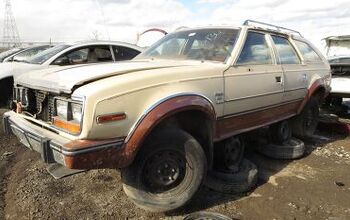Junkyard Find: 1995 Eagle Summit AWD Wagon

It’s hard to keep track of all the twists and turns of the drama involving Chrysler, Mitsubishi, and American Motors vehicles and branding during the last quarter of the 20th century — and that’s without even bringing Rootes Group stuff into the cast of characters.
The Eagle Summit Wagon, which was a left-hand-drive Mitsubishi RVR slapped with the badges of a marque named for a long-defunct AMC vehicle and not much related to the Mirage-based Eagle Summit car, is a good example of an obscure Mitsu-Chrysler sold just a few years before a bunch of Daimler DNA got added to the Chrysler genome.
We saw this ’93 Eagle Summit FWD Wagon a couple of years back, and now here’s an AWD example that I spotted in Denver last month.
If there’s a low-American-sales-figure Japanese four- or all-wheel-drive vehicle, you’ll find it in a Colorado wrecking yard — sooner or later.
This one didn’t have particularly high miles on the clock when its career came to an end.
Perhaps it failed to pass Denver County’s not-very-rigorous (compared to California, where I once lived) emissions test.
Sold in Denver (or a Denver suburb), will be crushed in Denver.
Of course, all the different-colored body panels from other badge-engineered RVRs (including the hood from a Plymouth Colt Vista wagon) weren’t doing the resale value of this car any favors, so perhaps the final owner just gave up on it due to lack of sufficient cup holders.
In Europe, the ’95 RVR (badged as a Space Runner) was sold using this “your life is over now that you have children, so who cares what kind of car you drive?” ad campaign.
In Japan, the RVR was ideal for hauling a busted-legged Daffy Duck in the back seat.

Murilee Martin is the pen name of Phil Greden, a writer who has lived in Minnesota, California, Georgia and (now) Colorado. He has toiled at copywriting, technical writing, junkmail writing, fiction writing and now automotive writing. He has owned many terrible vehicles and some good ones. He spends a great deal of time in self-service junkyards. These days, he writes for publications including Autoweek, Autoblog, Hagerty, The Truth About Cars and Capital One.
More by Murilee Martin
Latest Car Reviews
Read moreLatest Product Reviews
Read moreRecent Comments
- Funky D The problem is not exclusively the cost of the vehicle. The problem is that there are too few use cases for BEVs that couldn't be done by a plug-in hybrid, with the latter having the ability to do long-range trips without requiring lengthy recharging and being better able to function in really cold climates.In our particular case, a plug-in hybrid would run in all electric mode for the vast majority of the miles we would drive on a regular basis. It would also charge faster and the battery replacement should be less expensive than its BEV counterpart.So the answer for me is a polite, but firm NO.
- 3SpeedAutomatic 2012 Ford Escape V6 FWD at 147k miles:Just went thru a heavy maintenance cycle: full brake job with rotors and drums, replace top & bottom radiator hoses, radiator flush, transmission flush, replace valve cover gaskets (still leaks oil, but not as bad as before), & fan belt. Also, #4 fuel injector locked up. About $4.5k spread over 19 months. Sole means of transportation, so don't mind spending the money for reliability. Was going to replace prior to the above maintenance cycle, but COVID screwed up the market ( $4k markup over sticker including $400 for nitrogen in the tires), so bit the bullet. Now serious about replacing, but waiting for used and/or new car prices to fall a bit more. Have my eye on a particular SUV. Last I checked, had a $2.5k discount with great interest rate (better than my CU) for financing. Will keep on driving Escape as long as A/C works. 🚗🚗🚗
- Rna65689660 For such a flat surface, why not get smoke tint, Rtint or Rvynil. Starts at $8. I used to use a company called Lamin-x, but I think they are gone. Has held up great.
- Cprescott A cheaper golf cart will not make me more inclined to screw up my life. I can go 500 plus miles on a tank of gas with my 2016 ICE car that is paid off. I get two weeks out of a tank that takes from start to finish less than 10 minutes to refill. At no point with golf cart technology as we know it can they match what my ICE vehicle can do. Hell no. Absolutely never.
- Cprescott People do silly things to their cars.






















































Comments
Join the conversation
I used to really like these as a kid. Someone in our neighborhood had a white Plymouth Colt Vista, and it looked like a simple, honest-to-goodness little van. Back then I was always into dorky vans, so this was befitting. In college, my first boyfriend had a 1990 Nissan Axxess. That was the same basic principle, being a small minivan. However, the Axxess is even more rare than the Mitsubishi trio (sold only in 1990 in the US), had very Japanese futuristic 80's styling, and unlike the other vsns of the time; had dual sliding doors. Parts were even relatively easy to find, since the mechanicals were shared with the more-common Nissan Stanza I grew to love that van. It was easy to park in the city, fuel efficient, incredibly roomy, great visibility, and was just unique. But it had a tough life. The boyfriend constantly brushed it against a roof pillar in the apartment complex parking lot, the sunroof leaked and the interior eventually smelt like mildew, and the engine mounts were out; at idle the car shaked relentlessly. The mini-minivan idea is a fantastic one that just never caught on here
Despite the single sliding door, I see these as an early crossover more than a micro-van. These were poorly marketed and disappeared just as the Toyota RAV4 became available. In addition to the Expo LRV that this Eagle is a clone of, there was also a longer Expo AWD with four hinged doors. Throw bigger tires on either of these and Mitsubishi could have developed the car-based crossover market instead of Toyota.